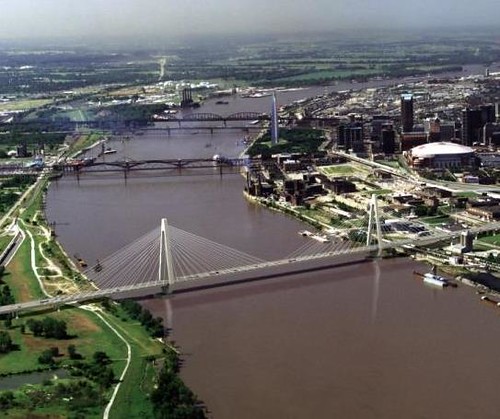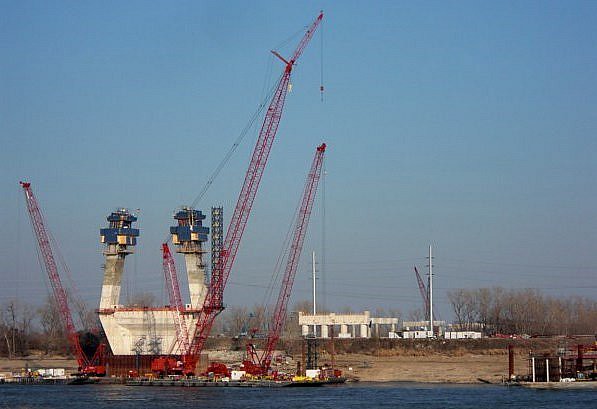 The new Mississippi River Bridge project, slated for completion in early 2014, is starting to show significant progress. The towers on both banks of the river are now clearly rising into the air. When completed, the main span of this 1,500 feet long, cable-stayed bridge will be the third-longest in the United States. The bridge towers will reach 400 feet, exactly the same height as the 31-story Laclede Gas Building in downtown St. Louis.
The new Mississippi River Bridge project, slated for completion in early 2014, is starting to show significant progress. The towers on both banks of the river are now clearly rising into the air. When completed, the main span of this 1,500 feet long, cable-stayed bridge will be the third-longest in the United States. The bridge towers will reach 400 feet, exactly the same height as the 31-story Laclede Gas Building in downtown St. Louis.
The project is built at a total cost of $667 million: a Missouri side North I-70 interchange at $57M; the bridge itself, including MO & IL approach structures at $346M, and on the Illinois side the relocated I-70 roadways including a tri-level interchange at $264M. The bridge will have two lanes in each direction and could be restriped to three lanes each way in a later phase if traffic would necessitate this.

{east bank tower and I-70 approach in Illinois}

{west tower rising}

{east tower rising}

{a closer look at the bridge tower on the Missouri side}

{The future cable-stayed bridge under construction}
When finished, I-70 will be rerouted over the new bridge, away from the Poplar Street Bridge (the present situation). This will significantly reduce traffic volumes on the PSB, as well as on the depressed/elevated section of I-70 which currently divides downtown St. Louis and its riverfront.

{Missouri approach}

{construction of new I-70 overpass}

{view of downtown from new bridge on-ramp}

{the elevated section of I-70 as seen from North Broadway}
It is a foregone conclusion that a “lid” over the depressed section of I-70 will be built to reconnect the Arch grounds with Kiener plaza and downtown St. Louis. This solution addresses one part of the problem. A few hundred yards to the north lies the other part, a much more visible obstacle.
Once the new Mississippi river bridge is completed we would like to see this obstacle, the elevated section of I-70, removed. It is not only a barrier between downtown St. Louis and Laclede’s Landing and the north riverfront, but it effectively cuts off downtown from North Broadway and the near north side, an area that seems poised for a comeback with much enhanced infrastructure such as the new bridge, a new Cass Avenue and North Tucker Boulevard under construction. Further, it will enhance the viability of new plans brewing for the Bottle District.

{new I-70 interchange at Howard leading to Cass and N. Tucker}
It is hard to forecast exactly what will happen to traffic volumes on the downtown section of I-70 after the new river bridge has been completed. That they will decrease is a given. The new Mississippi river bridge is providing us with a window. Through this window, we should take a good hard look at the existing infrastructure and make a serious effort at righting the wrongs that happened to downtown in the past.
Let’s not precondemn this opportunity as a bridge too far.



